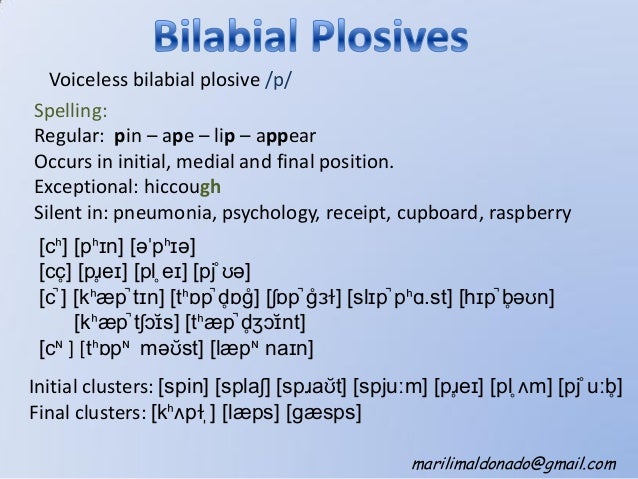Plosives Sounds In English
Posted : admin On 03.11.2019I'm Tim and this is my pronunciation workshop. Here I'm going to show you how English is really spoken. Come on, let's go inside. Wow. Isn't the world an amazing place? Look how many countries there are! Well – at least ten! Do you like travelling?

Alll the sounds produced in the English are either voiced or voiceless. Voiced sounds occur when the vocal cords vibrate when the sound is produced. There is no vocal cord vibration when producing voiceless sounds. PLOSIVE STORY /p/ /b/ /t/ /d/ /k/ /g/ A stop, plosive, or occlusive is a consonant sound produced by stopping the airflow in the vocal tract. Use the consonant chart on the right to hear and repeat each one of these plosive consonant phonemes.
Plosives Definition

How many countries have you visited? Now, is there any particular place, or country, that you'd like to visit? This is what the people of London told us when we asked them that same question.VoxpopsI'd like to visit Iceland.I'd like to visit South America.I'd like to visit Spain and Greece.I'd love to go to Egypt.TimThe contraction 'I'd' ends in the sound /d/, doesn’t it?
Apr 20, 2013 Plosive sounds in English language prepared by Farhad Ahmad and Sarwan Ayob, students in college of arts, university of Duhok. Slideshare uses cookies to improve functionality and performance, and to provide you with relevant advertising.
Plosives Sounds In English Dub

Listen again - can you fully hear the /d/?VoxpopsI'd like to visit Iceland.I'd like to visit South America.I'd like to visit Spain and Greece.I'd love to go to Egypt.TimWe make the sounds of English in different ways, using different parts of our mouths. There's a group of consonants called plosives, and if this sounds a bit like the word 'explosion', well, that's not a bad way of remembering it. Plosive sounds are made by suddenly releasing air that has been blocked by various parts of the mouth. The sound /d/ is one of these plosives. The others are /b/, /t/, /p/, /k/ and /g/. But in fluent, everyday speech, when one word ends in a plosive sound and the next begins in another consonant sound, we don’t always hear the release of the plosive sound. 'I'd like to', becomes 'Idliketuh'.
This is called 'an unreleased stop', or, if you want to get really technical, 'a stop with no audible release'. Here are some more examples.ExamplesHow about a qui ck chat?You shoul d thank her.It was a sa d time in his life.Why don't you si t down?TimRight, so you've heard the examples, and now it's your turn. You know the drill by now: listen and repeat.ExamplesHow about a qui ck chat?You shoul d thank her.It was a sa d time in his life.Why don't you si t down?TimWell done. And remember, if you want to learn more about this, then please visit our website, bbclearningenglish.com. And that is about it from the pronunciation workshop for this week.
I'll see you soon. Now, if you were to ask me where I'd like to visit next well – anywhere! I just love travelling.
Now let's see if we can find my next destination. I hurt my finger again!